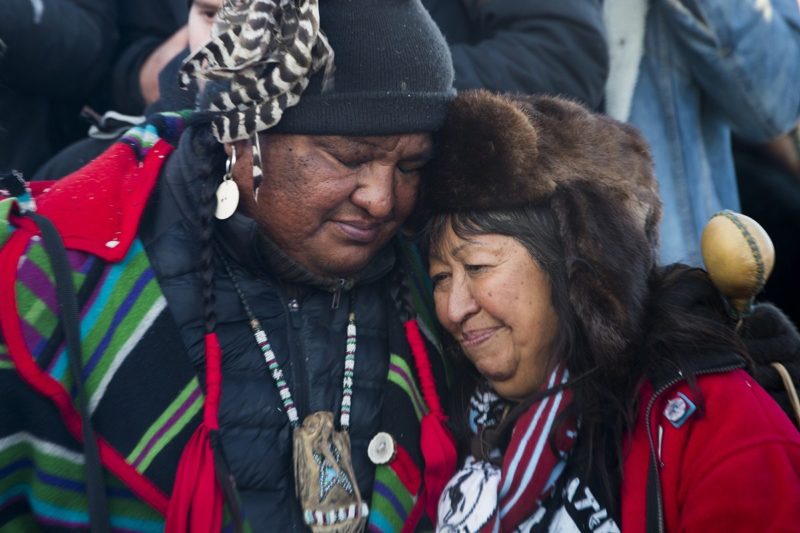Indigenous Love: When Being Who We Are Is Resistance
The saying “Kill the Indian, save the man” was more than a popular mantra that explained the explicit policies of anti-Native cultural destruction. It was also about shutting down more dynamic and fluid definitions of gender.

When we see depictions of Native people “in love,” it is often on a romance novel cover. A man with washboard abs and long shiny hair embraces a woman with braids and a mainstream body type (thin physique, large breasts, and a perfectly round ass) who is wearing a sexy “buckskin” fringe dress.
Under settler colonialism, these images of “savage love”—a barely clad “brave” and his “squaw”—sexualize “traditional” clothing and reinforce the idea that people of European descent are superior to Native people. With images like this abounding in U.S. society, beauty standards changed in Native communities. And so have gender roles.
But this “savage love”—with its stereotypical Indian bodies and its sharp male-female binaries—is not a reality for us.
In some Native communities, elders knew there are more than two genders and more than one way to be a “man” or a “woman.” The narrowing of these identities is one way that assimilation has decimated Native communities. The saying “Kill the Indian, save the man” was more than a popular mantra that explained the explicit policies of anti-Native cultural destruction such as imposing new property rules on Native communities or forcing us to stop speaking our languages or practicing our religions. It was also about shutting down more dynamic and fluid definitions of gender.
This romanticized savage love is not realistic based on our experiences. We grew up on the rez in Laguna, New Mexico, a village apart from each other, and have been friends for more than half our lives. While we had very different family structures, we share the same beliefs about our traditions, the sacredness of our Pueblo language, and the importance of being indigenous.
We try to show our children that it is okay to cast off notions of what it means to be feminine or masculine because colonization brought toxic masculinity to our communities. Binary gender roles and ideals have altered how Native people interact with each other, how we move together, how we raise our children, and how we practice our traditions. It seems like our indigenous communities are waking up to all the possibilities of gender expression, sexuality, and ways that families in our communities are formed after generations of being forced to be “civilized.” We are lucky that, as a couple, we share those values of not correcting our children when they like something that is not specific to their gender, and that’s reflected in how we interact with each other as husband and wife.
While we are a cisgender married couple, I (Rachael) am not straight. I am pansexual, and this aspect of my identity informs how I perceive how our traditions and the potential of our children’s role in those traditions. Our children may feel in their hearts that living as the gender assigned to them at birth is not how the Creator made them.
It makes me hopeful when I see the transgender women in our community in a “manta” or black traditional dress, or when one of my in-laws, who is a transgender man, is told the masculine Keres-language saying for “be strong.” It shows my husband (Justin) that the space we occupy together is safe for him to express himself in ways that do not fit colonial ideals of masculinity. If I can help him carry that part of himself even when I am not around, and he can be an example to our son, I know the love and respect we have for each other as indigenous people is a beautiful resistance against a hypersexualized, mythical, and historically inaccurate depiction of us.
Consciously subverting gender norms is also an awakening for ourselves as separate indigenous people with different likes and dislikes, coming together to raise a family and be part of an indigenous community that we can help heal from the generational trauma caused by colonial belief systems.
While I was an undergraduate at the University of New Mexico, Justin and I decided to see where a single date would take us. That one date led us to dig deeper within ourselves about what a relationship would mean. We had to consider what it meant to be in a serious relationship: Justin is part of the Antelope Clan, which is at the top of the hierarchy of our clan system. Even though I was not his wife yet, I had to consider what responsibilities he already carried and, if we got married, how important my role would be to him and to our community as a whole.
We chose to take the dive anyway. I went to his family home to help him care for his grandfather. He sat with my parents and me at their home for dinner. We took off entire weekends to be with our families during our most sacred and secret ceremonies, trying to take in all the food while not fully succeeding at blocking the drama that always accompanies families. He gave me space during our ceremonies to finish my homework or, later, the work that comes with sitting on a board of directors.
Now we have two children who are recognized by the Pueblo of Laguna and tribal council. As we have gotten older and (I hope) wiser, we are continually learning how to balance the life we’ve created together in the city with our religious and family responsibilities back home on the rez.
Indigenous love is larger than us as two people; it is the future of our communities and the survival of our language and our culture.
